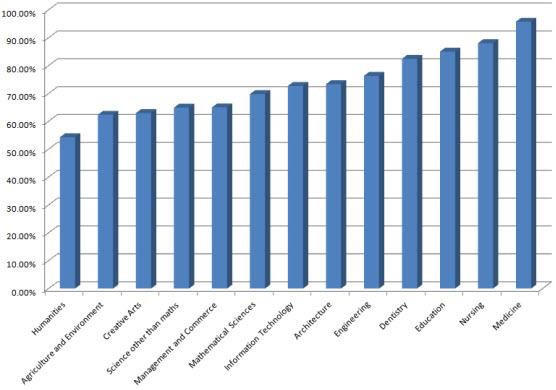Published on Crikey, Tuesday 22 January 2013
Media coverage of the Grattan Institute’s Mapping Australian higher education, 2013 report released this week has focused on the public policy implications of doubtful university-related debt through the HELP scheme. One missing link in the media coverage is the link between discipline studied and chances of getting a professional job.
The report uses 2011 census data to explore job prospects of bachelor-degree graduates by the main discipline studied. As we would expect, there are big differences between degrees. People with degrees in health-related disciplines generally have a very good chance of getting professional or managerial jobs – about 90% of those in work and not currently studying for many sub-disciplines.
People with degrees in the humanities and social sciences find it much more difficult to find work matching their qualifications. Between half and two-thirds, depending on discipline, are in professional and managerial jobs.
Bachelor-degree graduates in work and not currently studying who have a job as “managerial” or “professional”

The federal government has strongly promoted university science education, though for 2013 it quietly increased the price of science subjects up after four years of heavy discounting. From a marketing perspective, the government’s selling of science was very successful. The number of people applying for and enrolling in science degrees soared.
But there never was any strong evidence that more science graduates were needed, and the 2011 census confirmed the labour market is over-supplied. Except in earth sciences, bachelor-degree science graduates have below-average employment outcomes.
Turning to the issue of the likelihood of HELP debt not being repaid, taxpayers stand to lose as much as $6.2 billion of the $26.3 billion in student debt – former students are predicted to earn less than $49,000 a year in Australia through most or all their lives.
Some of these HELP debtors are working overseas. The non-repayment of their student debt is a policy issue, but unlikely to be a personal problem for those involved. The people in Australia but not earning more than the income threshold are a more interesting, and perhaps more concerning group. Was their higher education an unsuccessful investment? Does their experience provide a warning to others seeking higher education?
We know too little about the people not paying back their HELP debt. The HELP doubtful debt figures are based on advice from the Australian Government Actuary. There is little public domain information on how they calculate doubtful debt, other than that it is based on Australian Taxation Office data. The ATO possesses the most accurate records of income within Australia, but collects limited information on other potentially important characteristics. It has no data on which disciplines HELP debtors studied.
Another missing characteristic in ATO data is whether the HELP debtor finished a degree or not. About 20% of people who start university do not complete a qualification. They are likely to earn less than graduates, and so are perhaps less likely to repay their HELP debt. We know that completions decline with ATAR, and so this aspect of the doubtful debt problem may increase as more low-ATAR students are enrolled.
The ATO does collect information on gender. We know from the census that full-time labour force participation for women with bachelor degrees declines in their 30s, usually due to raising children. Part-time work or leaving the labour force are obvious reasons why someone might earn less than $49,000 a year.
But ATO data shows that women owe 57% of all HELP debt, which is what we would expect. Women have had been around this share of total enrolments in recent years. With HELP debt taking on average about eight years to pay off, perhaps most female HELP debtors repay before leaving full- time work.
We need a better understanding of the causes and correlates of HELP doubtful debt. It could help prospective students make better decisions, and reduce how much the HELP scheme is costing other taxpayers.